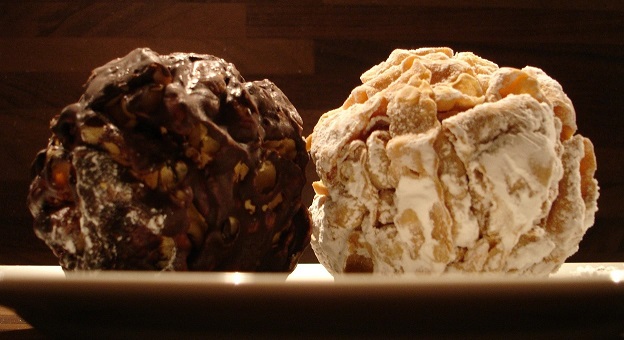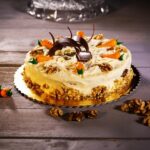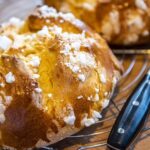
The medieval town of Rothenburg ob der Tauber is known for its cobbled streets, half-timbered houses – and one curious confection: the Schneeball. Named for its snowball-like appearance, this golden, deep-fried pastry is dusted with powdered sugar and enjoyed throughout Bavaria and Franconia.
Though relatively unknown outside Germany, Schneeballen (plural) have been part of local baking traditions for over 300 years. In this article, you’ll learn how to make this iconic treat at home, complete with variations, preparation tips, and a peek into its culinary heritage.
The Origins of Schneeball Recipe
The Schneeball (Schneeballen or “snowballs”) originates from Franconia, a cultural region in northern Bavaria. Its home is Rothenburg ob der Tauber, where bakeries display them in countless flavors and coatings – from the traditional powdered sugar to chocolate, cinnamon, coconut, and even marzipan-covered varieties.
Historically, Schneeballen were reserved for weddings, holidays, and special occasions, partly because of their rich ingredients and time-consuming preparation. Today, they’re a tourist favorite and local delicacy, often purchased as edible souvenirs from Rothenburg’s pastry shops.
Ingredients for Traditional Schneeballen
Schneeballen are made from a rich shortcrust dough flavored with butter, eggs, and a touch of schnapps. The dough is rolled, sliced into strips, shaped into balls, and deep-fried until golden, then dusted with powdered sugar.
Ingredients (Yields 10–12 Schneeballen):
- 500 g (4 cups) all-purpose flour
- 1 tsp baking powder
- 75 g (1/3 cup) sugar
- Pinch of salt
- 100 g (7 tbsp) cold unsalted butter, cut into cubes
- 3 eggs
- 100 ml (scant 1/2 cup) sour cream or crème fraîche
- 1 tbsp vanilla sugar (or 1 tsp vanilla extract)
- 1 tbsp schnapps (optional but traditional – use plum or pear schnapps)
- Vegetable oil for deep frying (sunflower or canola)
- Powdered sugar for coating
Optional Coatings:
- Melted dark or white chocolate
- Cinnamon sugar
- Chopped nuts
- Coconut flakes
Tools and Equipment
- Mixing bowl and rolling pin
- Pastry wheel or sharp knife
- Kitchen scale (for precision)
- Heat-safe slotted spoon or spider
- Deep fryer or heavy-bottomed pot
- Oil thermometer (for frying control)
- Schneeball tongs or metal sieve (optional but helpful for shaping)
Step-by-Step Instructions
Step 1: Make the Dough
In a large bowl, whisk together flour, baking powder, sugar, salt, and vanilla sugar. Add cold butter and rub it into the flour using your fingertips until the mixture resembles coarse crumbs.
In a separate bowl, whisk the eggs with sour cream and schnapps (if using). Pour the wet mixture into the dry ingredients and knead until a firm but pliable dough forms.
Shape into a disc, wrap in plastic, and let it rest in the fridge for 30 minutes.
Step 2: Roll and Slice the Dough
On a lightly floured surface, roll the dough out to about 2 mm (1/8 inch) thick. Using a pastry wheel or knife, cut the dough into strips about 1 cm wide and 10–12 cm long.
Take 6–8 strips, loosely bunch them together, and twist or crumple slightly without pressing too tightly. Place the bundle in a Schneeball tong or press gently into a metal sieve to form a ball. Repeat with the remaining dough.
Step 3: Heat the Oil
Heat oil in a deep fryer or large pot to 170–180°C (340–355°F). Use a thermometer to ensure even frying.
Step 4: Fry the Schneeballen
Lower each ball carefully into the hot oil using a slotted spoon or in their forming sieve. Fry for 5–7 minutes, turning gently to ensure even browning.
Remove once golden brown and drain on a paper towel-lined tray.
Step 5: Coat and Serve
Let the Schneeballen cool slightly, then dust generously with powdered sugar. For variations, dip in melted chocolate, roll in cinnamon sugar, or top with chopped nuts.
They are best served on the day they’re made, but can be stored in an airtight container for up to a week.
How to Serve Schneeballen
Schneeballen are most often served:
- With afternoon coffee or tea
- At festivals, especially in Franconian towns
- As a dessert centerpiece at celebrations
- Packaged in boxes as souvenirs from Rothenburg
Traditionally eaten cold or at room temperature, Schneeballen pair well with:
- German-style coffee
- Fruit compote or jam
- A glass of plum schnapps or Riesling
Variations and Flavor Ideas

While powdered sugar is the classic coating, modern bakeries in Rothenburg offer countless variations:
- Chocolate Dipped: Dark, milk, or white chocolate coatings with sprinkles
- Cinnamon Sugar: Especially popular in winter
- Almond or Nut-Crusted: Dipped in chocolate then rolled in crushed nuts
- Glazed Schneeballen: Coated in lemon or vanilla icing
- Stuffed Schneeballen: Some experimental versions are filled with marzipan or nougat
At home, feel free to experiment with spices in the dough, including cinnamon, nutmeg, or cardamom for holiday flair.
Fun Facts About Schneeballen
- Schneeballen were historically reserved for weddings and religious holidays.
- Their name comes from their powdered sugar coating, resembling a snowball.
- They can last up to 8 weeks when packaged airtight, making them ideal souvenirs.
- Schneeballen are traditionally made using special tongs or sieves, but home cooks often improvise.
- Despite their fame, Schneeballen are relatively unknown outside Bavaria.
Schneeballen are more than just deep-fried dough – they’re a sweet symbol of Rothenburg’s culinary history and a festive treat enjoyed for generations. With their crunchy texture, snow-dusted appearance, and endless variation possibilities, they offer both a taste of the past and a canvas for modern creativity.
Whether you stick with tradition or invent your own flavor twist, Schneeballen bring the charm of German baking straight to your kitchen.
Ready to explore more classic sweets? Try our recipes for Vanillekipferl, Swabian Cream Cake, or German Apple Cake next.







